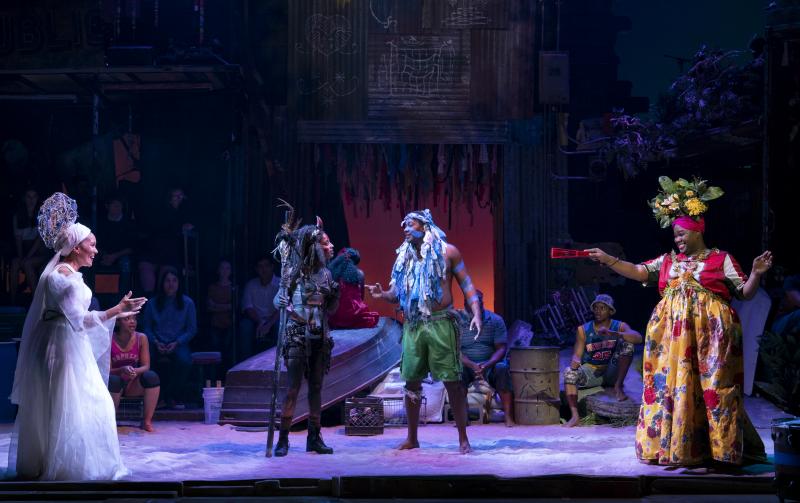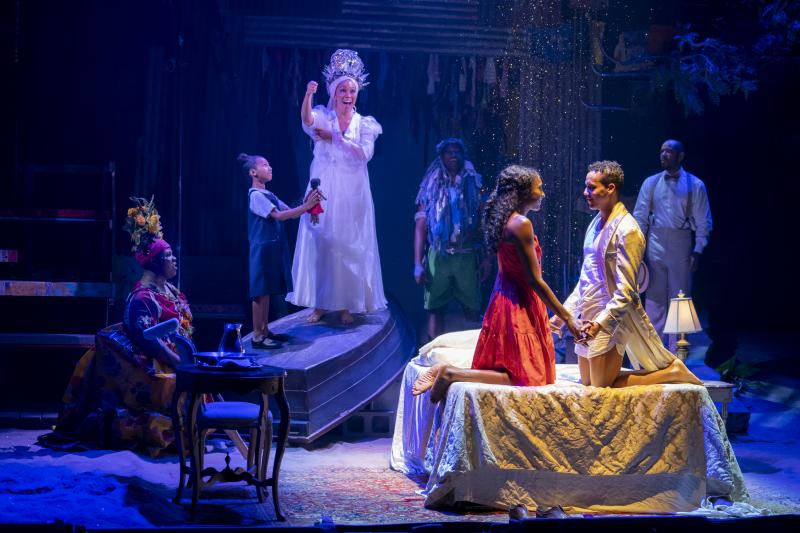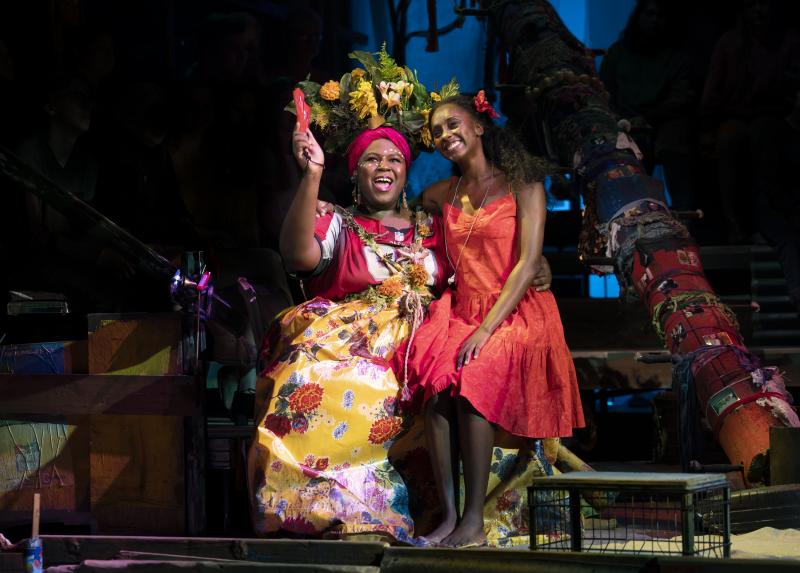Review: ONCE ON THIS ISLAND at TUTS Is Raw, Real Storytelling at Its Finest

"This--something, life and...breath?" my friend read as she tried to decode my jumbled mess of notes while I drove us home from the show. "Oh, no" I answered, "that says, 'This musical lives and breathes.'" That short phrase, scribbled mid-show into my notebook is most indicative of my experience at ONCE ON THIS ISLAND, a show whose movement, melodies, and people formed together before us, seemingly as a new animate creature. A tale of "two worlds never meant to meet", ONCE ON THIS ISLAND delivers a 90-minute sung-through litany of joyous song, dance, and storytelling.
Set on an island in the French Antilles in the time "Then & Now", ONCE ON THIS ISLAND is a story-within-a-story, detailing the legend of Ti Moune (Courtnee Carter), a peasant girl who fell in love with a well-to-do white man she saved from a storm. Ti Moune's own life was once saved by the gods, and after years of daydreaming and wondering, now she considers if their purpose in saving her was for her to meet him. The four gods of earth, water, love, and death--Asaka (Kyle Ramar Freeman), Agwe (Jahmaul Bakare), Erzulie (Cassondra James), and Papa Ge (Tamyra Gray)--play an instrumental role in the lives of the islanders. Hearing her prayers, they compose a situation for Ti Moune to rescue the man she feels drawn to, Daniel Beaxuhommes (Tyler Hardwick). Ancestral history and racial prejudice runs deep in the separation between the black people of Ti Moune's village and the white aristocratic people Daniel descends from.

ONCE ON THIS ISLAND. Photo by Joan Marcus.
Director Michael Arden expressed in the program note that following disasters, "...we rebuild not only with hammer, nail, and whatever materials are available, but through the healing power of storytelling". I can't help but feel sentimental, as the structure of this show reminded me what theatre really is at the end of the day: people coming together to play and tell stories. This simple reminder permeated all facets of the show, informing the designs, the direction, and the performances.
The choice to have the actors onstage as the audience was being seated before the show began allowed us the privilege of watching them interact and just be with one another, before they took on their roles in the show. Typically, the space of the theatre transforms as the orchestra hums the first notes of the overture and the curtain rises, revealing the world onstage to the audience. In this production, however, the environment is on display like a living diorama from the moment you enter the theatre. Actors mill about onstage, accompanied by audience members taking their onstage seats (an option available to patrons to further immerse themselves into the show). There is a sense of community throughout the cast, made up of a range of ages, even before the show begins.
.jpg)
ONCE ON THIS ISLAND. Photo by Joan Marcus.
One of my favorite components of this type of stripped-down storytelling was the presence of musicians and sound engineers onstage using buckets, drums, and pipes to add to the layers of sound. The sound design team, originated by Peter Hylenski and adapted for the tour by Shannon Slaton added layers of environmental resonance to the show. Throughout the show, found objects made up set pieces from a car, to a hotel room, to a stage and curtain for casting shadows. This again emphasized the role of this community in literally putting together the pieces to tell a story before your eyes.
Plot-wise, ONCE ON THIS ISLAND was inspired by Hans Christian Anderson's "The Little Mermaid". Knowing this explains why this script (written by Lynn Ahrens) has no shortage of common motifs. The major conflict is between the two sides of the island, and an 'Us versus Them' mentality that runs so deep, there is no hope for resolution. Further, our main character Ti Moune (Courtnee Carter) fulfills the classic "daydreamer ingénue desiring freedom from her hometown" role, which you've certainly seen before. However, what I believe you haven't seen is the way this story is told, and the nuances that make it stand out from typical fairy-tale predictability. To my delight, there was more to the plot than what I was able to foresee.
The score, composed by Stephen Flaherty, is catchy, jubilant, and expressive. The opening number "We Dance" delightfully establishes the style of this show, with syncopation and rhythm to spare, as the company welcomes you to the ways of the island. "Mama Will Provide" illustrated the pledge of the gods to watch over Ti Moune's path, and was easily my favorite of the night. Freeman commanded the stage as the god of earth, Asaka, and left me wanting more and more.
Camille A. Brown's explosively rhythmic choreography was showcased in many joyous numbers throughout the show, most especially in "Ti Moune's Dance". Performed with brilliance by Courtnee Carter, this is the kind of number that seems to synchronize with your own heartbeat, earning a wealth of applause mid-show.

as 'Ti Moune'. Photo by Joan Marcus.
Dane Laffrey's set design is a stimulating hodge podge of textures and colors, complete with odds and ends, scraps of fabric, and real sand and water onstage. The environment onstage is as vibrant and animate as the individuals dancing within it. Let's be real, who wouldn't be happily surprised to see actual rain pouring down on the actors and sand flying up from their feet as they dance? Clint Ramos's costume design contributes to the patchwork feel of the show, with everything from Abercrombie crop tops to sport jersey's decorating the ensemble onstage. Drawing the variety of colors and textures together is the thoughtfully saturated lighting design by Jules Fisher and Peggy Eisenhauer, adding a wash of bright hues to the stage. The lighting dramatized moments of extreme within the story, whether it be evil, goodness, harmony, or one of the many thunderous storms.
While us theatre people know very well how to suspend our disbelief, this production doesn't require much for you to be emerged into their world. So often nowadays it seems that theatre is constructed to show as little of the behind the scenes as possible, but this production finds beauty in displaying the cogs of the machine, as if the performers onstage are letting you in on the secret. ONCE ON THIS ISLAND is a beauty in both content and form, as it brings us back to the basis of what theatre is in the first place. It's refreshing, it's something I haven't seen before, and it made me feel all the feelings-I'll always count that as a win.
ONCE ON THIS ISLAND runs at The Hobby Center for the Performing Arts now through March 1st with performances Tuesdays through Thursdays and Sundays at 7:30pm, Friday and Saturday at 8:00pm, and Saturday and Sundays at 2:00pm. Visit tuts.com or call 713-558-8887 for tickets and more information. Tickets start at $40 with no additional fees.
Reader Reviews
Videos

